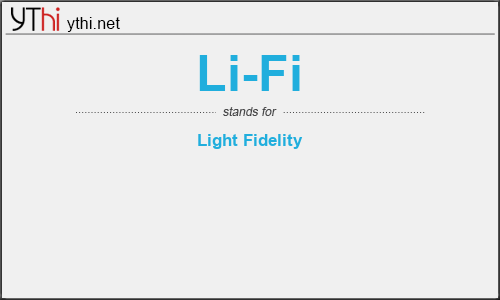What does Li-Fi mean? What is the full form of Li-Fi?
The full form of Li–Fi is Light Fidelity.
Li-Fi (short for light fidelity) is wireless communication technology which utilizes light to transmit data and position between devices. The term was first introduced by Harald Haas during a 2011 TEDGlobal talk in Edinburgh.
In technical terms, Li-Fi is a light communication system that is capable of transmitting data at high speeds over the visible light, ultraviolet, and infrared spectrums. In its present state, only LED lamps can be used for the transmission of visible light.
In terms of its end use, the technology is similar to Wi-Fi — the key technical difference being that Wi-Fi uses radio frequency to induce a voltage in an antenna to transmit data. Whereas Li-Fi uses the modulation of light intensity to transmit data. Li-Fi can theoretically transmit at speeds of up to 100 Gbit/s. Li-Fi’s ability to safely function in areas otherwise susceptible to electromagnetic interference (e.g. aircraft cabins, hospitals, military) is an advantage.The technology is being developed by several organizations across the globe.
LiFi is a game-changing innovation that can transmit enormous amounts of data through LEDs (Light Emitting Diodes). An application of Visual Light Communications, Lifi was announced as the faster, more secure, and energy-efficient successor of today’s WiFi, which can transmit data at speeds that are 100 multitudes faster.
Where it all started
There wouldn’t be LiFI if it weren’t for Alexander Graham Bell and his discovery of Visual Light Communications technology (VLC). Bell found out that visible light can be used for the transmission of data through one of his notable inventions, the Photophone.
Bell’s Photophone
On February 19, 1880, Alexander Graham Bell and his assistant Charles Sumner Tainter jointly invented the photophone. The photophone was a device that transmitted speech on a modulated beam of sunlight. By the 3rd of June 1880, Tainter was on the roof of the Franklin school and transmitted a wireless voice telephone message to Bell, who was in his laboratory that was 213 meters or 700 ft. apart from Tainter’s location.
The device was patterned after the telephone at the time, but the difference between the two is that the Photophone used modulated light for wireless transmission, instead of electrical signals carried over a wire circuit that the telephone used.
The sound by which the sender emits is taken in by the Photophone transmitter that is projected towards a mirror, the resulting sound would then cause similar vibrations on the mirror while sunlight is being directed into the vibrating mirror, it would then project it back to the receiver into converted sound.
Bell regarded the Photophone as his most important invention, and that it was “greater than the telephone” on his deathbed during an interview with a reporter. The device made significant changes to optical communications technology and was a predecessor to fiber optics and VLC.


Leave a Reply
You must be logged in to post a comment.